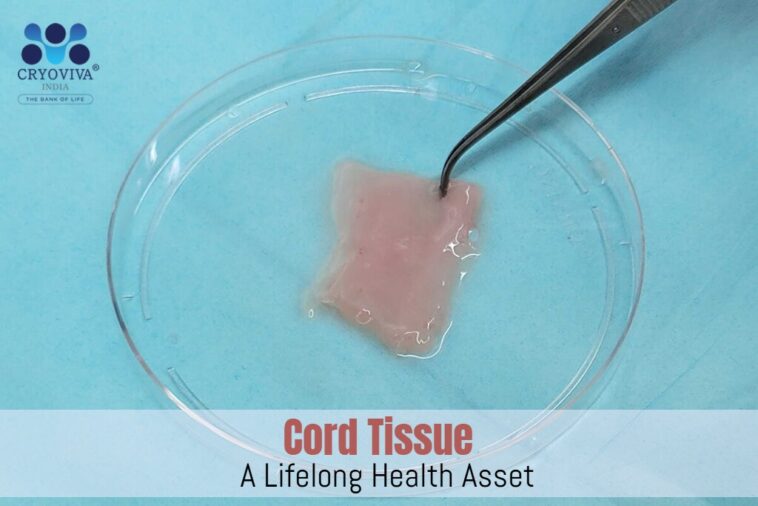Cord tissue is a valuable source of stem cells that play a crucial role in regenerative medicine. It also holds promise in gene therapy and personalized medicine, expanding its potential in future medical innovations. Therefore, preserving cord tissue after birth can provide significant health benefits for your child. It is like a ray of hope for treating conditions that were once considered incurable.
Let us decode the importance of preserving cord tissue in detail:
Importance of Preserving Cord Tissue
Let us first understand why and how preserving cord tissue can become a lifelong health asset with numerous health benefits for your child’s future.
- Biological Properties
Found in the umbilical cord (often discarded after birth), surrounded by Wharton’s jelly, cord tissue is rich in mesenchymal stem cells (MSCs). These MSCs exhibit immunomodulatory properties, meaning they can regulate immune responses. This specific property makes them highly beneficial for treating autoimmune diseases and inflammatory conditions.
MSCs also secrete bioactive molecules such as growth factors and cytokines, which aid in tissue repair and inflammation control. In particular, MSCs release vascular endothelial growth factor (VEGF) and transforming growth factor-beta (TGF-β), critical for angiogenesis (formation of new blood vessels) and wound healing. These cells can develop into various tissue types, such as bone, cartilage, and neural cells. Unlike other stem cell sources, cord tissue MSCs show higher proliferation rates and better adaptation to laboratory cultivation.
Additionally, MSCs derived from cord tissue exhibit low immunogenicity, meaning they are less likely to trigger immune rejection, making them ideal candidates for allogeneic (donor) therapies.
- Therapeutic Applications
Banking cord tissue provides multiple treatment opportunities throughout life. Recent research shows that cord tissue stem cells (MSCs) have the potential to treat several diseases, including:
- Heart and kidney diseases, particularly in cases of ischemic injury and fibrosis
- Neurological conditions like Alzheimer’s and Parkinson’s
- Autoimmune disorders
- Sports injuries and wound healing
- Diabetes and organ regeneration
- Spinal cord injuries and cerebral palsy
- Reduce inflammation
- Support tissue regeneration
Recent clinical trials have demonstrated the efficacy of MSCs in treating graft-versus-host disease (GVHD), a common complication following bone marrow transplants. Furthermore, preclinical studies indicate that MSCs could potentially aid in reversing liver cirrhosis and chronic lung diseases.
- Ensure Safety
Cord tissue stem cells are considered safe as no patient deaths, toxicity, or other complications have been reported. They have been successfully used in over hundreds of clinical trials worldwide for a variety of conditions. Additionally, MSCs from cord tissue are less likely to develop genetic mutations compared to adult stem cells, enhancing their safety profile. Although these cells are yet to be approved by FDA, showing promising results in clinical trials, particularly for Alzheimer’s, Parkinson’s, and organ regeneration.
Steps to Preserve Cord Tissue
Preserving cord tissue involves a simple, safe process done after the baby’s delivery. Here’s how it works:
- Collection at Birth
A small segment (approx. 6 inches) of the umbilical cord is collected after cutting. This process is safe for both vaginal and C-section (cesarean) deliveries. Collection takes place under sterile conditions to prevent contamination and ensure the integrity of the stem cells.
- Cleansing and Storage
The cord segment is cleansed and placed in a sterile container with antibiotics. Later, it’s safely transported to a laboratory with collected cord blood. Advanced storage solutions include using temperature-controlled shippers to maintain optimal conditions during transportation.
- Cryopreservation
The collected tissue is cryo-preserved in its natural state. This step ensures the viability of stem cells for future use. Cryopreservation involves using liquid nitrogen (-196°C) to halt all biological processes, ensuring the cells remain viable indefinitely. Additionally, modern cryobanking techniques use cryoprotectants to prevent ice crystal formation, which can damage cells.
Wrapping Up
Consequently, preserving cord tissue is a long-term health investment. This provides your child with access to state-of-the-art medical treatments as and when required. With ongoing advancements in stem cell therapy, banking cord tissue today could unlock future medical breakthroughs, including 3D bioprinting of organs and personalized regenerative medicine. So, take proactive steps to safeguard your child’s well-being today through cord tissue banking.
If you’re looking for a trusted partner, consider Cryoviva. At Cryoviva, you can preserve your child’s cord tissue in a natural state without compromising quality. We use an advanced cryopreservation method that maintains the tissue’s full potential. We handle everything from collecting the tissue to storing it safely. By choosing Cryoviva, you can secure your child’s health asset for life.
This post was created with our nice and easy submission form. Create your post!





